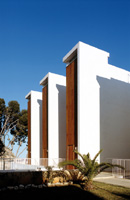
Tonet Sunyer Vives
Urbanización plurifamiliar, Jávea. Alicante
Multi-family development, Jávea, province of Alicante
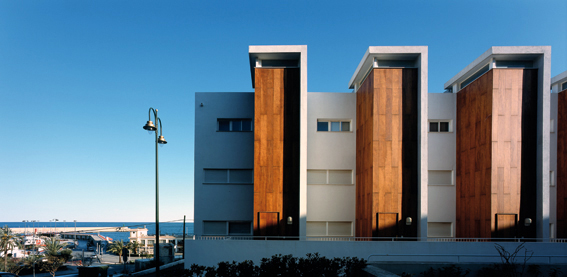
 |
Arquitecto/Architect: Tonet Sunyer Vives |
|
|
Urbanización plurifamiliar, Jávea. Alicante Multi-family development, Jávea, province of Alicante
|
 |
|
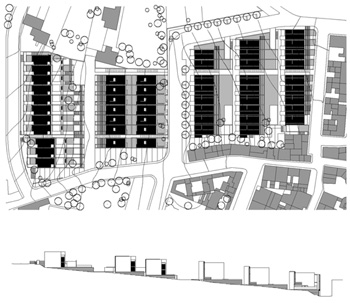
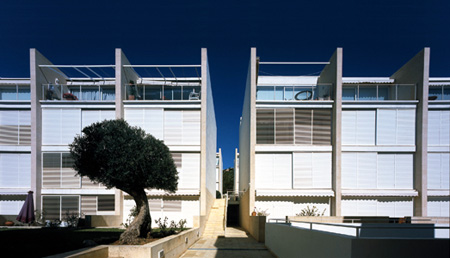
|
|||
| Situado a
pie del Montgó y muy cerca del puerto de Javea, se sitúa la
urbanización plurifamiliar de 80 viviendas pareadas.
Marca una calle que nos divide la parcela en dos manzanas, que llamaremos norte y sur, sobre las cuales establece unos parámetros urbanísticos diferentes que hará que tipológicamente se aborden de manera distinta. La topografía existente, con un fuerte desnivel en sentido norte-sur y pendiente muy suave en sentido oeste-este, propició la creación de unas plataformas escalonadas que sirven de apoyo y eje generador del conjunto. Un plan urbanístico débil, influenciado por la omnipresencia geográfica del monte Montgó, así como por tratarse del límite de la ciudad hace que los ejes existentes no den orden y carácter a esta parte tan privilegiada de la ciudad. Así, debido a la diferencia de calificación urbanística entre las dos manzanas, en la manzana sur se implantan tres bloques de unidades de dos a tres viviendas agrupadas en vertical, paralelos a la calle que divide la urbanización, y de la misma manera se implantan tres bloques de viviendas unifamiliares pareadas en la manzana norte. Éstos a su vez están divididos en dos por un eje peatonal longitudinal que recorre la agrupación de norte a sur. Su longitud no es la misma porque se van adaptando a los límites de la parcela. La diferencia de niveles entre las plataformas de asiento de los bloques, hace que la última planta de cada uno quede por encima del bloque siguiente consiguiendo que, el máximo número de viviendas pueda disfrutar de la vista al mar. |
The
multi-family development of 80 semi-detached houses is located at the foot
of the Montgó, very close to the port of Javea.
A street divides the site into two street blocks, which we shall call northern and southern, to which different town planning criteria apply. As a result, the building types are tackled in a different way. The land slopes sharply from north to south and very gently from west to east, favouring the creation of staggered platforms to support the whole and act as its generating axis. The weakness of the town plan, partly because of the geographic omnipresence of Mount Montgó and partly because the site is on the town’s edge, means that the existing axes do not give this exceptionally positioned area any order or character. As a result of the different urban zones that the two street blocks fall into, three blocks of units of two to three dwellings grouped vertically are placed in the southern street block, parallel to the street dividing the development, while three blocks of semi-detached family houses are sited in the northern street block. These in turn are bisected by a longitudinal pedestrian axis running through the complex from north to south. Their length is not the same because they fit in with the boundaries of the site. The differences in level between the platforms on which the blocks are seated means that the top story of each is higher than the following block, so a maximum number of dwellings can enjoy a view of the sea. |
|
Situación/Location: Puerto de Jávea, Aduanas del mar. Alicante/Port of Jávea - Aduanas del Mar. Alicante Promotor/Developer: Colaboradores/Collaborators: Aparejador/Surveyor: Constructor/Contractor: Fotógrafo/Photographer: |
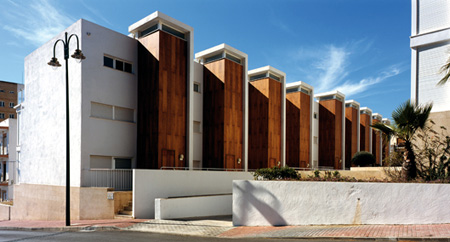 |
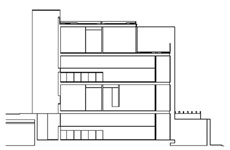 |
||
 |
|||
 |
|||
| Entre los edificios de la manzana sur, se generan espacios verdes
de uso privado con jardín y piscina comunitaria. Debajo de cada una de
estas plataformas se sitúan los parkings. La diferencia de cota entre una
plataforma y otra hace que el jardín y el parking, queden en planta baja
y en planta sótano respectivamente para un bloque y queden a cota de
planta primera y a cota de planta baja para el siguiente. El acceso a las
viviendas de planta baja se produce a través de unos corredores cubiertos
por el paso superior que son iluminados y ventilados por unos patios que
van marcando un ritmo además de quitarle el sentido de pasillo cerrado
que de otra manera tendría. A las viviendas superiores se accede a
través del paso situado en cota del jardín.
En cuanto a los tipos de vivienda, como ya hemos apuntado anteriormente, difieren sobre todo entre la manzana sur y norte. En la manzana sur, de aprovechamiento más intenso, se crean dos tipos de base, un dúplex en planta baja y un dúplex en planta segunda con acceso desde la primera. Estos se van adaptando según la demanda, en apartamentos de una sola planta, de planta y media o de dos plantas y media. En cuanto a materiales, monocapa blanco, piedra amarillo fósil, panel fenólico y persiana de aluminio blanco construirán el exterior y mármol blanco, madera de arce, DM lacado y yeso, el interior. Finalmente, el proyecto fue limitado en su reglamentación de edificabilidad y se tuvo que reducir la densidad de construcción, por lo que solamente se construyó la manzana sur, dejando la manzana norte como área verde. |
Private green spaces with a garden and communal
swimming pool are generated between the buildings in the southern street
block. The car parks are located under each of the platforms. The
difference in level between one platform and the next means that the
garden and the car park are at ground floor and basement level
respectively for one block and at first floor and ground floor level in
relation to the next. The ground floor flats are reached by passages which
are covered by the passage above and lit and ventilated by wells that mark
a rhythm as well as removing the sense of a closed corridor that they
would otherwise have. The upper flats are reached by the passage at garden
level.
As regards the type of dwelling, as mentioned above the difference is above all between the southern and northern street blocks. In the southern one, which is more densely built, two types of basic unit are created: a ground floor duplex and a second floor duplex reached from the first floor level. Depending on demand, they are adapted to create single-storey, one-and-a-half storey or two-and-a-half storey apartments. The materials are white one-layer render, fossil yellow stone, phenolic panels and white aluminium shutter blinds for the exterior and white marble, maple wood, lacquered MDF and plaster on the interior. In the event, the permitted surface area regulations limited the project and the building density had to be reduced, so only the southern street block was built, leaving the northern one as a green area. |
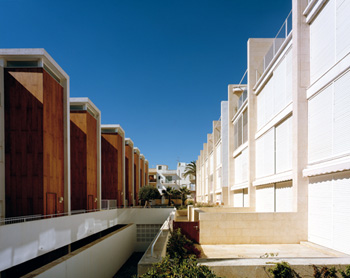
|
|